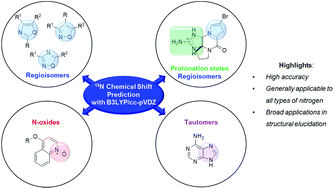Systematic investigation of DFT-GIAO 15N NMR chemical shift prediction using B3LYP/cc-pVDZ: application to studies of regioisomers, tautomers, protonation states and N-oxides†
Abstract
The calculation of 15N NMR chemical shifts has been systematically investigated using density functional theory-gauge including/invariant atomic orbitals (DFT-GIAO) approximation at the B3LYP/cc-pVDZ level of theory. General linear regression terms for 15N chemical shift predictions were calculated for nitromethane and liquid ammonia references in DMSO. Both aliphatic and aromatic nitrogens were studied using a diverse set of molecular scaffolds. Statistical error analysis between experiment and prediction revealed that, with the exception of primary amines, 95% of linear scaled N-15 chemical shifts are within a ±9.56 ppm range. Comparison of the 15N calculated isotropic chemical shifts with the experimentally determined chemical shifts provided accurate assignment of the correct structure in cases where experimental data was ambiguous or inconclusive. Application of 15N prediction proved to be highly effective in identifying the correct regio-isomer, oxidation state, protonation state and preferred tautomer in solution.



 Please wait while we load your content...
Please wait while we load your content...